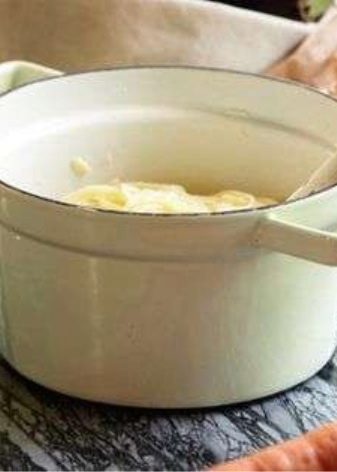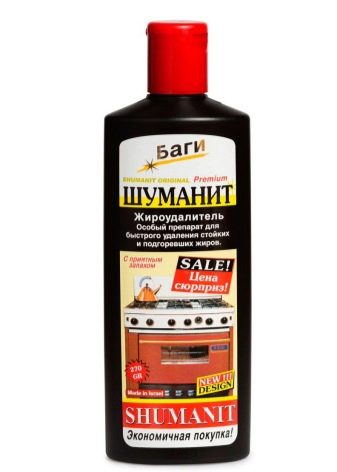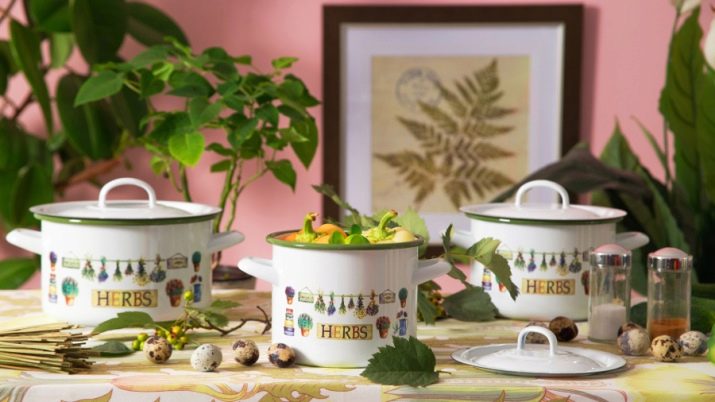Enameled dishes have a large number of positive qualities. It is hygienic, easy to clean and does not enter into a chemical reaction with food. The dishes prepared in it are distinguished by good taste due to excellent heat conductivity. You can also store cooked food in it for quite a long time. Therefore, she enjoys well-deserved popularity and love of all the hostesses, taking her place of honor in the kitchen.
The life of the pan depends not only on the care of it, but also on the quality of the product itself. In order for the enameled pan to last a long time, first you need to choose the right quality product.

There are several criteria for choosing such dishes:
- Enamel must be applied by dipping. Then the layer is thicker and stronger, resistant to mechanical and thermal damage. When buying on the side of the pan, you can see from 2 to 4 gray dots, which are the place of attachment when immersed in enamel, the walls of such dishes will also be thicker;
- The neck of the container should be metallic and even;
- It is desirable that the pan is white inside. Colored enamel can be toxic.
What pollution are there?
Contamination can be different, caused by time, improper use or burnt food.
In the summer season, the most common problem is a thick candied layer of burnt jam, which sometimes cannot be completely cleaned. It is important to remember that the enamel pan is not suitable for cooking such food, the food in it burns quickly.

In the process of operation, housewives are faced with the resulting yellow or dark bloom, enamel darkening.To prevent this, kitchen utensils must be taken care of and from time to time to clean with folk and household tools.
As previously stated, food in enamel dishes quickly burns up, if you do not overlook it. Therefore, pollution such as soot, burnt food, or smudges often appear.
It is strictly forbidden to cook dairy dishes, for example, cereals based on milk, in such dishes. Milk quickly burns and leaves a whitish coating, which is difficult to clean in the usual way.
When cooking fatty foods, a coating of fat forms. It is difficult to wash it with any dishes, so after cooking it is important to immediately clean the pan. Limescale may form due to poor-quality water, in which case precipitate falls on the walls of the dishes.


How to wash?
If the trouble nevertheless occurred, and the pan burned, you need to know Some useful rules for cleaning it:
- You can not leave the dishes for a long time, pollution must be dealt with immediately after the incident;
- In no case should you soak it in cold water. A sharp change in temperature can damage the enamel (cracks will appear).
You can clean the pan at home using different types of chemicals - chemical (household chemicals) and folk.

How to clean quickly?
Household cleaning
Household chemicals can help quickly and without any effort to get rid of pollution. Before using chemicals, be sure to read the instructions.
It is also important to observe protective measures, work only with gloves and ventilate the room. After use, it is important to rinse the dishes thoroughly, and it is best to boil to prevent the substance from getting into food. Consider some cleaning compounds and their use in more detail:
- Dishwashing Detergents. We heat the dishes on the stove and pour hot water, add a few drops of detergent. We stand for about 2 hours, after draining the water and washing it under warm running water. If this does not help, then pour the stain on the product and stand for about 10 hours, washing it with a sponge under warm running water;
- Sanita Ultra Shine - A universal creamy cleaner that can be used to clean any pots. It copes well with dirt, thin greasy and calcareous deposits (scale);
- Cleaning paste Astonish - It is also a universal cleaning agent, suitable for dishes and gas stoves, microwave ovens and sinks;

- Spray Tytan - A special tool that helps fight carbon deposits. It is enough to spray it on the contaminated area and hold for 5 minutes, then rinse under warm running water;
- "Shumanit". A very strong substance that can cope with even the most corrosive pollution. However, it is very toxic and has a pungent odor, so it is necessary to provide good ventilation in the room, work exclusively with rubber gloves and use the product only on the outside of the dishes. Application: spray the product on the surface and hold for 30 seconds. Wipe with a damp sponge and wash thoroughly under running water.
- "White". It can also be used only on the outside of the pan. Application: pour cool water into a cold container, take 2 caps of the product in 2 liters of water. We leave it, even if the dishes and water are warmed to room temperature (about two hours), and put on gas, bring to a boil. After draining the water and repeat the procedure. Finally, rinse thoroughly under warm running water to completely wash off bleach.


Home remedies
The advantage of home-based methods is their accessibility and health safety:
- Acetic essence, baking soda and citric acid. In a small amount of warm water, dissolve 30 grams of soda, about the same amount of vinegar and half a bag of citric acid. In the end, you should get a liquid slurry. We take a sponge and with its help we distribute the product along the bottom and walls with rubbing movements.Stand for 30 minutes, then rinse under warm running water. The recipe is suitable for removing darkening and soot;
- Coffee cake. You can use both fresh and stale. Do not worry about the safety of enamel, coffee is not able to damage its integrity, but copes well with dirt. We collect with a sponge thick and three places of pollution, from time to time we wash away dirt and we apply a fresh portion of thick. Cleaning takes a maximum of 15 minutes;
- Salt. Ordinary salt will help get rid of the blackness inside. We collect a handful of coarse salt and sprinkle soot, then pour water so that it covers the contaminated area completely. We stand 2 hours. Then put on fire and boil for 30 minutes. Black patches literally before our eyes will move away from the coating;

- From burnt milk, soda ash will help. Pour water into the container and stir 60 g of soda in it, boil for 3 minutes;
- Against dark plaque, a recipe based on persol or vinegar will also help. We dissolve one persol tablet in warm water and boil for 60 minutes. Vinegar: a liter of water + 50 ml vinegar. Boil for 2 hours;
- A solution of vinegar will help get rid of yellow plaque. Take 150 ml of vinegar per liter of water. Boil the solution for 2 hours. As a prophylaxis for the appearance of yellowness, the procedure can be performed up to two times a month;

- Dark plaque is well removed sweet carbonated drinks. They include orthophosphoric acid, which is able to break down organic formations. To do this, pour soda in the container and leave for 50 minutes. If the coating does not disappear, then boil for an additional 30 minutes;
- Exposure to cold. This is the easiest way, put the chilled pan for 60 minutes in the freezer, and then clean off the carbon;
- Milk serum. Fill the pan 1 cm above the contaminated area. Leave for 24 hours and wash with the usual dish detergent. The serum contains lactic acids that return the enamel to its original white color.


Enamel pan is not suitable for long cooking jam, preservation or boiling. However, if this still happened, from burnt jam The following remedies will help to get rid:
- Concentrated salt solution. We prepare a working solution: a liter of water + 120 g of salt. Pour the solution so that it covers all contaminated areas. We boil for a maximum of 45 minutes, observing the process, if the dirt leaves earlier, the gas can be turned off;
- Activated carbon. Take one blister (10 tablets) and crush it to a powder. We powder the burnt bottom and stand for 30 minutes. We add water and again we sustain 30 minutes. After washing under running water with ordinary cleaning products;
- Laundry soap. Take one bar of soap and grind on a fine grater. Pour chips into water, alter until they are completely dissolved and cook for 2 hours.

- Finish tablets. Dissolve one tablet in water and boil for 20 minutes;
- Apple peel from sour apples. Fresh burnt jam can be wiped with fresh apple peel and then rinse the pan with warm water. If the burnout has not receded, then fill the peel with water and boil for 20 minutes. Malic acid breaks down sugar crust from jam well;
- Ash. The method is perfect for those who are in the country or in nature. We fill the pan with ash by 1/3 and pour warm water. We put the capacity on fire, boil for about 30 minutes. Pour the liquid and wash as usual.
Ordinary non-burnt smudges from the outside can be easily removed with a sponge dipped in vinegar or medical alcohol. Slightly burnt smudges are removed with saline, for this we wet the sponge in it and wipe the dirt.

If the smudge is very burnt and turns black, then:
- Cool the container;
- We prepare the cleaning mixture: 100 g of soda + 5 ml of detergent + 50 ml of hydrogen peroxide. Spread the mixture according to contamination;
- Stand for 10 minutes and wash under running water.
To completely clean the dishes, you need to choose the appropriate container into which you can immerse the whole, for example, a basin or an iron bucket. We fill the container with water and put on fire, heat it. Add to hot water: for 5 liters of water = a bottle of stationery glue + 150 g of baking soda. Mix thoroughly and bring to a boil. Reduce the heat and lower the pan into the water for 20-30 minutes. After waiting for cooling and wash under running water.
In the summer, you can use the old, but proven method - cleaning sand. To do this, pour sand into the pan with three hard sides of the sponge or a rag. We change sand from time to time. The procedure lasts about 60 minutes, after cleaning the surface of the dishes will shine like new.


People's councils
To extend the life of enameled dishes must be observed a few rules:
- Buying a pan is not worth rushing with its use, first you need to "temper" it with hot water. To do this, pour cool water to the top so that it reaches the neck. We put the container on the stove and bring the water to a boil, then turn off the gas. You can drain only after the water has cooled. After this procedure, you can safely cook in a pan;
- You should not store foods that contain acids for a long time in a bowl, for example, salad with vinegar or lemon juice, sliced apples;
- You can’t put a cold pan on a hot stove and pour cold liquid into a hot pan;

- Damage to the enamel at the bottom can occur for reasons such as sudden changes in temperature, if the bottom of the pan is much wider than the burner when drying dishes on a hot stove;
- If the food is still burnt, the container must be emptied and filled with warm water. You can wash it only with soft sponges;
- Do not use metal brushes or chemical abrasive cleaners when cleaning. This can damage the integrity of the enamel and lead to the ingestion of harmful toxic substances of the alloy into food, and with it into the body; chips on the surface of the enamel indicate the unsuitability of the dishes.
Thus, it is possible to clean a burnt enameled pan with the help of the achievements of modern industry, as well as with folk methods.
Use enameled dishes carefully, following the rules of operation.
And then she will delight you with delicious dishes and beautiful appearance for a long time.

You can find out how to properly wash an enameled pan with vinegar from the next video.
Burnt milk is a problem that can be dealt with effortlessly. Details can be seen in the video tips.










